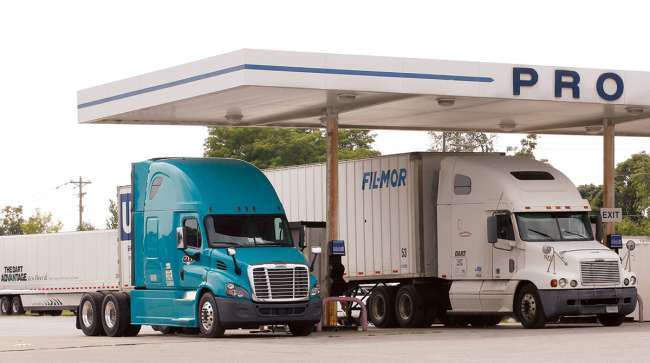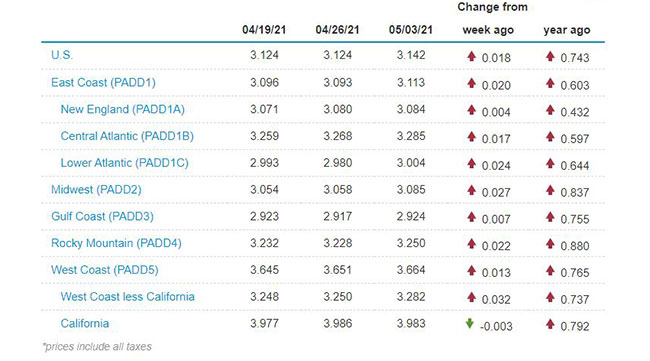Senior Reporter
Diesel Price Resumes Rise, Increases 1.8¢ to $3.142 a Gallon

[Stay on top of transportation news: Get TTNews in your inbox.]
The national average price for diesel increased 1.8 cents to $3.142 a gallon, according to Energy Information Administration data released May 3.
The increase came after the price of trucking’s main fuel was unchanged at $3.124 on April 26.
A gallon of diesel costs 74.3 cents more than it did at this time last year.
U.S. average on-highway #diesel fuel price on May 3, 2021 was $3.142/gal, UP 1.8¢/gallon from 4/19/21, UP 74.3¢/gallon from year ago https://t.co/4hrLKYpAZM #truckers #shippers #fuelprices pic.twitter.com/Rj42EmkoLj — EIA (@EIAgov) May 4, 2021
Nine of the 10 regions in EIA’s weekly survey saw the price rise, with the largest being 3.2 cents in the West Coast less California. Only California saw a decline — three-tenths of a cent.
The national average price of a gallon of gasoline also rose 1.8 cents, to $2.890 a gallon.
The price of diesel is above $3 a gallon in nine of the 10 regions in the EIA report, with only the Gulf Coast region showing prices slightly below that mark at $2.924 a gallon, up 75.5 cents from a year ago and up seven-tenths of a cent week-to-week climbing from $2.917 the previous week. The Gulf Coast is home to much of the nation’s oil and gasoline refining capacity and typically fuel prices there are lower than the rest of the nation, in part because of lower transportation costs.
Meanwhile, the price of crude oil kept inching upward, closer to the $70-a-barrel level. West Texas Intermediate, the industry benchmark, is up to $2.67 a barrel since the end of April, sitting at $66.25 a barrel at the close of business May 4. That’s up from $63.58 on April 30.
Oil industry analyst Tom Kloza with the Oil Price Information Service told Transport Topics that the rising cost of all oil products is being driven by some investors in the market who are seeing increases in a wide variety of commodity prices, including ethanol. But he sees price increases beginning to slow later in the spring and summer.
“It’s a bit of a runaway market,” Kloza said. “There is a tremendous dependency for fuel prices to hit their peak in May and the typical drop from May 5 to mid-July is about 23%. So there is typically a haircut for runaway prices in May and June. But it is impressive. Oil prices, diesel, gasoline, ethanol all have been up sharply.”
U.S. average price for regular-grade #gasoline on May 3, 2021 was $2.890/gal, UP 1.8¢/gallon from 4/19/21, UP $1.10/gallon from year ago https://t.co/ZJc3ymdRBt #gasprices pic.twitter.com/GfzdEjXBFD — EIA (@EIAgov) May 4, 2021
Even as the U.S. economy is showing strong signs of recovery with the latest gross domestic product at 6.4% annual growth, above most economists’ expectations, the Atlanta Federal Reserve Bank is forecasting second-quarter GDP to reach an annualized rate of 10.4% through the end of June. If that rate is reached, it would be the second-strongest rate of growth since 1978, exceeded only by the record-breaking expansion seen during the third quarter of 2020 as the U.S. plunged into a deep recession because of the COVID-19 pandemic.
The EIA is forecasting that even as more Americans take to the road this summer as COVID-19 restrictions are loosened, the average retail gasoline prices will gradually fall from a 2021 annual peak average of $2.86 a gallon in April to an average of $2.78 in July and $2.62 by September.
“Current price levels also reflect low gasoline inventory levels, partly resulting from reduced gasoline supply following significant refinery disruptions along the U.S. Gulf Coast in February and early March,” the EIA wrote in its Summer Fuels Energy Outlook. “We expect that growth in refinery output and rising crude oil supply from OPEC+ and U.S. tight oil producers will begin to put downward pressure on retail gasoline prices over the summer, despite an expected rise in gasoline demand.”
The latest Baker Hughes Rig Count shows that domestic oil production is continuing to increase, but is still below its pre-pandemic levels. According to Baker Hughes, 440 rigs were in operation the week ending April 30, which is up by two from the previous week. That compares with 408 a year ago when domestic oil production declined 8% in 2020 when measured against 2019. The EIA said U.S. crude oil production averaged 11.3 million barrels per day in 2020, down 935,000 barrels per day from the record annual average high of 12.2 million barrels per day in 2019.
The 2020 decrease in production was the largest annual decline in the U.S. Energy Information Administration’s records.
U.S. On-Highway Diesel Fuel Prices

EIA.gov
Want more news? Listen to today's daily briefing below or go here for more info:


